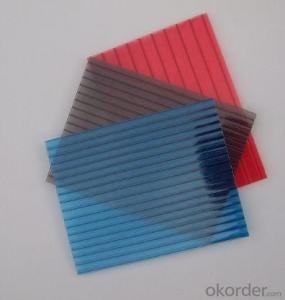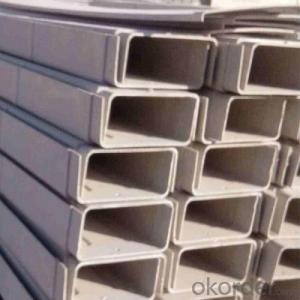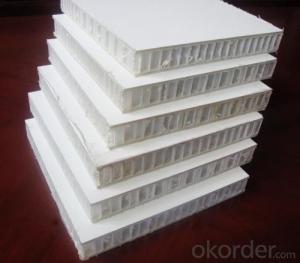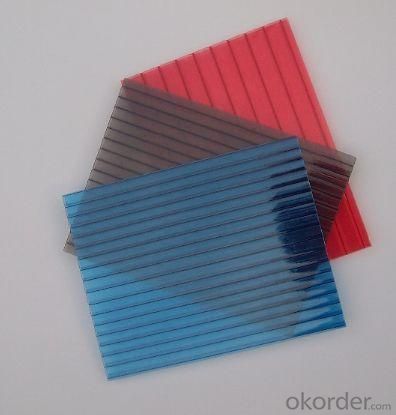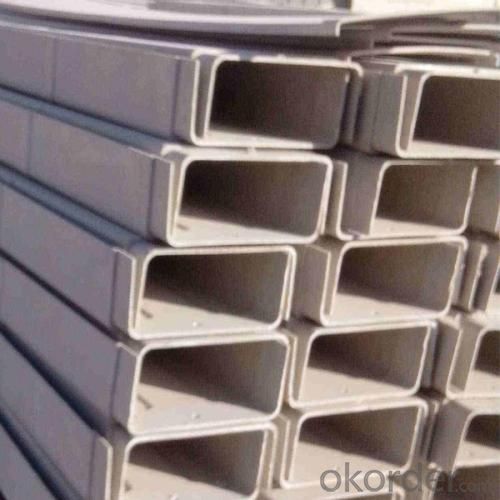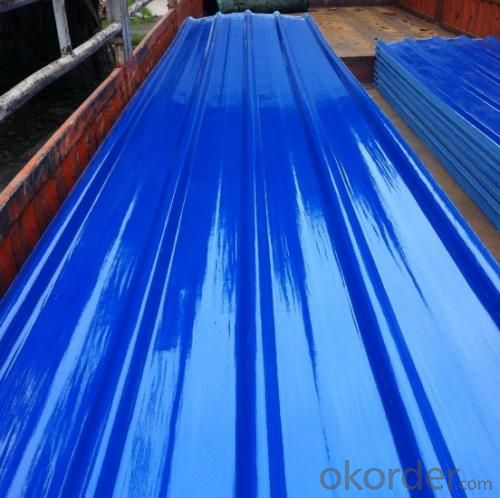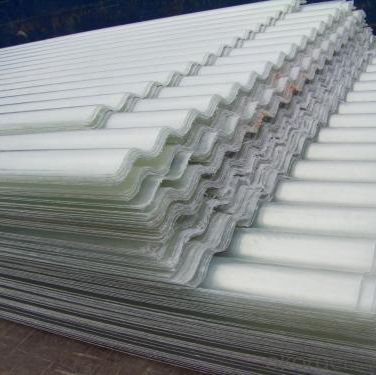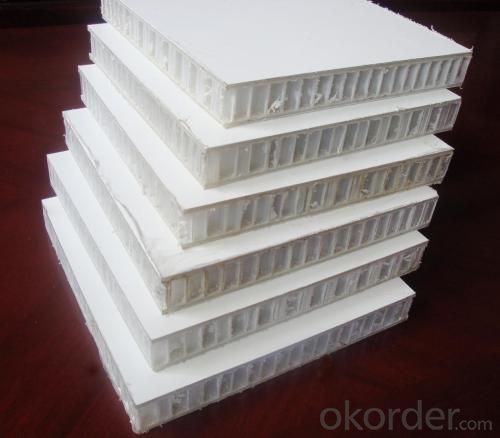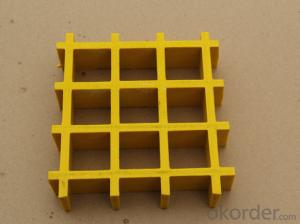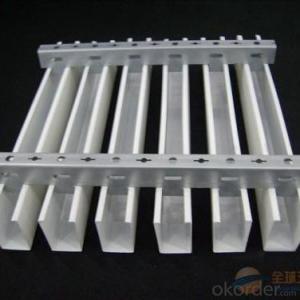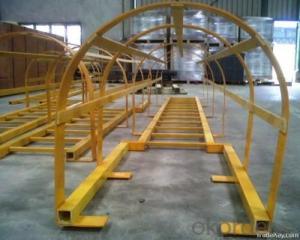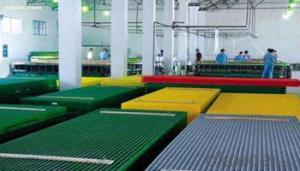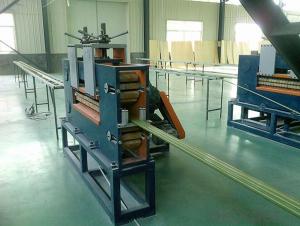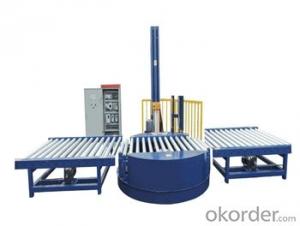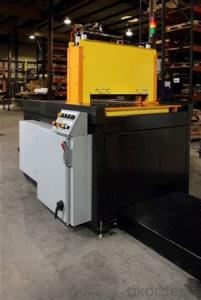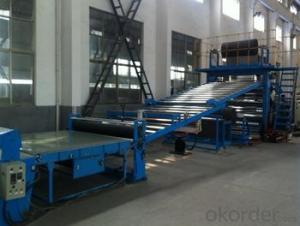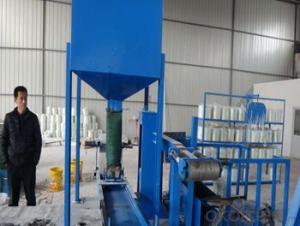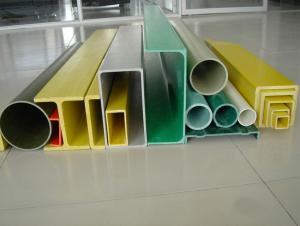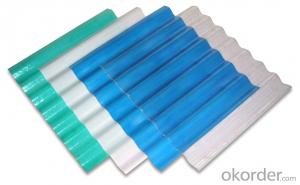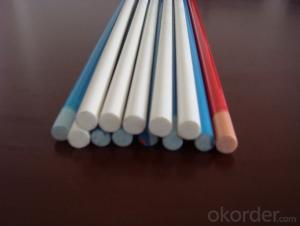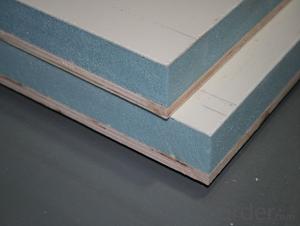FRP Pultrusion Profiles - Anti-Flammable, High-Quality FRP Pultruded Grating in Various Styles
- Loading Port:
- Tianjin
- Payment Terms:
- TT OR LC
- Min Order Qty:
- 1 m.t.
- Supply Capability:
- 100000 m.t./month
OKorder Service Pledge
OKorder Financial Service
You Might Also Like
PRODUCT DESCRIPTION
FRP pultruded grating has the most characteristics of molded grating, but it has its distinct advantages, it has very high fiberglass content in the loading direction, so it has very high load capability, it has more superiority when used at wide span, so that the basic support will be decreased and the project cost will be reduced accordingly.
SPECIFICATION
The standard space between two crossbars is 6 inch or 12 inch.
Thickness (mm) | Bar width (mm) | Open space (mm) | Open rate (%) | Approx weight (kg/m |
25.4 | 15.2 | 22.8 | 60 | 13.2 |
25.4 | 15.2 | 15.2 | 50 | 15.9 |
25.4 | 15.2 | 10.1 | 40 | 18.5 |
25.4 | 40 | 10.8 | 21 | 14.5 |
38.1 | 15.2 | 22.8 | 60 | 15.8 |
38.1 | 15.2 | 15.2 | 50 | 19.1 |
38.1 | 15.2 | 10.1 | 40 | 22.4 |
50.8 | 25.4 | 25.4 | 50 | 16.6 |
50.8 | 25.4 | 12.7 | 33 | 21.1 |
CHOICE FOR PULTRUDED GRATING
Resin: GP resin, ISO resin, VE resin, Phenol resin
Color choice: Yellow, gray, green, custom color
Surface choice: Groove surface, grit surface, lozenge cover surface
FEATURES
a. Anti-corrosion and anti-rust
b. Light weight and high strength
c. Anti-flammable
d. Anti- fatigue
e. Safe and anti-slippery
f. Anti-ageing
g. Easy of maintenance
h. Excellent electromagnetism property
i. Good economic benefit
FIELDS SERVED
Sewage treatment,
water supply and drainage,
chemical industry,
oil industry,
power engineering,
pulp and paper,
construction engineering,
spinning, marine engineering.
APPLICATION
Operation terrace,
stair walkway,
ground floor,
trench cover,
sidewalk,
foot bridge,
equipment safety fence,
scaffold.
COMPANT DESCRIPTION
CNBM,China National Building Materials Group is a state-owned enterprise in charge of administrative affairs in china building materials industry. Established in 1984, CNBM is a large group corporation of building materials with total assets of 25 billion RMB and a total staff of 30,000.CNBM now owns 200 subordinating firms of solely owned and joint-venture companies.
CNBM International Corporation is one subsidiary of CNBM, we focus on offering good-quality products,professional service and complete solution to our customers. Strong delivery capacity, advanced technology& management, strong financing capability and excellent after-sale service are our advantages in sharing international market.
FAQ
Q1.What's your sample policy?
A:We can supply the sample if we have ready parts in stock, but the customers have to pay the courier cost.
Q2.Can you produce according to the samples?
A: Yes, we can produce or modify the products according to your request.
Q3.How do you deliver the goods to my country?
A:We can provide international express, such as DHL, EMS, UPS, FedEx, etc. We select air freight and sea freight upon your requests. Quotations if without mentioning the shipping costs are shipping fee excluded.
Q4.How much does it cost to ship to my country?
A:When you goanna to place an order, please contact us, because different country has different freight.
Q5.How to get the catalogue?
A:please contact us and tell us what you are looking for.
We will try our best to meet customers' demands. Welcome you come here to visit us. We sincerely welcome partners around the world to establish business cooperation with us on the basis of mutual trust, benefit and development.
PICTURES
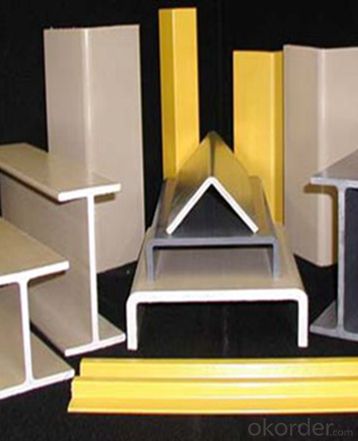
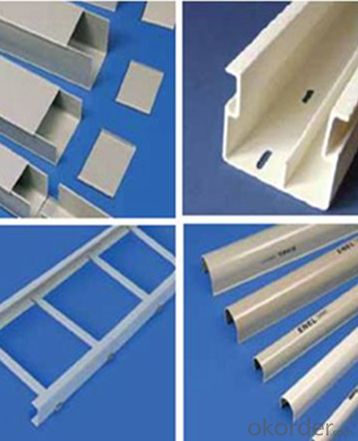
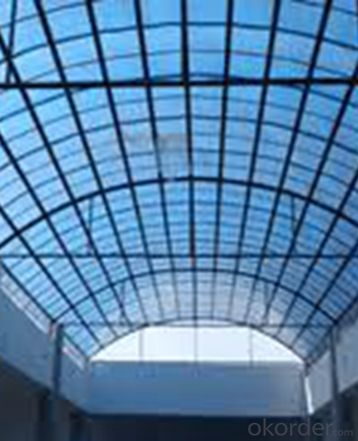
- Q: Can FRP pultrusion profiles be used in the construction of water slides?
- Water slides can indeed utilize FRP pultrusion profiles. FRP, which stands for Fiber Reinforced Polymer, is a composite material that offers numerous advantages in the construction of water slides. To begin with, FRP pultrusion profiles possess a remarkable combination of lightweight construction and remarkable strength, making them an ideal choice for creating the structural components of water slides. These profiles boast impressive strength-to-weight ratios, meaning they can withstand the dynamic loads and forces experienced in water slide applications without adding excessive weight to the overall structure. Moreover, FRP pultrusion profiles exhibit exceptional resistance to corrosion, which is of utmost importance in water slide construction. Given that water slides are constantly exposed to water, chemicals, and harsh weather conditions, traditional materials like steel tend to corrode and deteriorate over time. In contrast, FRP profiles are inherently corrosion-resistant, guaranteeing the longevity and durability of the water slide. Furthermore, FRP pultrusion profiles offer an abundance of design flexibility. They can be tailored to various shapes and sizes, enabling the creation of unique and thrilling water slide designs. These profiles are also easily moldable, allowing for the incorporation of various features such as slides, curves, and drops to enhance the overall water slide experience. Lastly, FRP pultrusion profiles possess exceptional thermal insulation properties. This proves advantageous for water slides as it helps maintain the temperature of the water, preventing excessive heat loss or gain. Such a feature enhances the comfort and enjoyment of users while simultaneously reducing energy consumption for heating or cooling the water. In summary, FRP pultrusion profiles are perfectly suited for water slide construction due to their lightweight nature, impressive strength, corrosion resistance, design flexibility, and thermal insulation properties.
- Q: Can FRP pultrusion profiles be used in renewable energy projects?
- Yes, FRP pultrusion profiles can be used in renewable energy projects. FRP (Fiber Reinforced Polymer) pultrusion profiles offer high strength, durability, and corrosion resistance, making them suitable for various applications in renewable energy projects. They can be used in the construction of wind turbine blades, solar panel frames, and structural supports for renewable energy infrastructure. Additionally, FRP pultrusion profiles can provide cost-effective solutions by reducing maintenance requirements and improving the overall performance of renewable energy systems.
- Q: Are FRP pultrusion profiles resistant to electrical arcing?
- Yes, FRP pultrusion profiles are highly resistant to electrical arcing due to their non-conductive nature, making them a safe choice for applications where electrical arcing is a concern.
- Q: Are FRP pultrusion profiles resistant to ultraviolet radiation?
- Yes, FRP pultrusion profiles are generally resistant to ultraviolet radiation. The combination of the composite material and the resin used in pultrusion manufacturing provides excellent UV resistance, making them suitable for outdoor applications.
- Q: Are FRP Pultruded Shapes poisonous?
- The products certified by SGS are basically reliable.If the food is best to use food grade resin, there is a health permit.
- Q: Are FRP pultrusion profiles resistant to alkaline substances?
- Yes, FRP pultrusion profiles are generally resistant to alkaline substances. The use of fiberglass reinforced polymer (FRP) in pultruded profiles provides excellent resistance to a wide range of chemicals, including alkaline substances. The resin used in the manufacturing process is typically a thermosetting polymer, such as polyester or vinyl ester, which offers high resistance to alkaline solutions. Moreover, the reinforcement of fiberglass imparts additional strength and durability to the profiles, making them highly resistant to corrosion and degradation from alkaline substances. However, it is important to note that the specific resistance of FRP pultrusion profiles to alkaline substances may vary depending on the specific resin formulation and manufacturing process. Therefore, it is recommended to consult with the manufacturer or supplier to ensure the profiles meet the desired resistance requirements for specific alkaline environments.
- Q: Are FRP pultrusion profiles resistant to moisture or humidity?
- Yes, FRP pultrusion profiles are highly resistant to moisture and humidity. The combination of fiberglass reinforcement and resin matrix used in their construction makes them non-corrosive and impervious to water absorption. This inherent resistance ensures their durability and performance in humid or moist environments without compromising their structural integrity.
- Q: Can FRP pultrusion profiles be customized according to specific requirements?
- FRP pultrusion profiles can be tailored to specific requirements, offering a wide range of customization options. Pultrusion is a manufacturing process that involves pulling continuous fibers through a liquid resin bath and then curing the resin in a heated die to achieve the desired shape. This process allows for flexibility in design and customization. Customization possibilities for FRP pultrusion profiles include dimensions, shapes, colors, and surface finishes. The dimensions can be adjusted to meet specific length, width, and thickness needs. Shapes can vary from basic geometries like rectangular or round profiles to more intricate designs with unique cross-sections. When it comes to color, FRP pultrusion profiles can be pigmented during manufacturing to achieve the desired shade or can be painted or coated afterward. This allows for matching specific color requirements or ensuring compatibility with existing structures or products. Additionally, surface finishes can be personalized to attain desired properties such as enhanced slip resistance, UV resistance, or fire resistance. Specific performance requirements can be met by applying surface treatments like sanding, coating, or adding special additives. Overall, FRP pultrusion profiles offer a high level of customization, making them suitable for various industries including construction, transportation, infrastructure, and aerospace. They are versatile, lightweight, corrosion-resistant, and possess excellent strength-to-weight ratios.
- Q: Are FRP pultrusion profiles resistant to mold and mildew?
- Yes, FRP pultrusion profiles are highly resistant to mold and mildew. The non-porous nature of the fiberglass reinforcement and the synthetic resin matrix used in pultrusion manufacturing make these profiles highly resistant to moisture absorption, preventing the growth of mold and mildew.
- Q: Can FRP pultrusion profiles be used in the construction and building materials industry?
- Yes, FRP pultrusion profiles can be effectively used in the construction and building materials industry. These profiles offer several advantages such as high strength-to-weight ratio, corrosion resistance, and dimensional stability, making them suitable for a wide range of applications including structural elements, handrails, gratings, and reinforcements. Additionally, FRP pultrusion profiles can be easily customized to meet specific project requirements, making them a popular choice in the industry.
Send your message to us
FRP Pultrusion Profiles - Anti-Flammable, High-Quality FRP Pultruded Grating in Various Styles
- Loading Port:
- Tianjin
- Payment Terms:
- TT OR LC
- Min Order Qty:
- 1 m.t.
- Supply Capability:
- 100000 m.t./month
OKorder Service Pledge
OKorder Financial Service
Similar products
Hot products
Hot Searches
Related keywords
